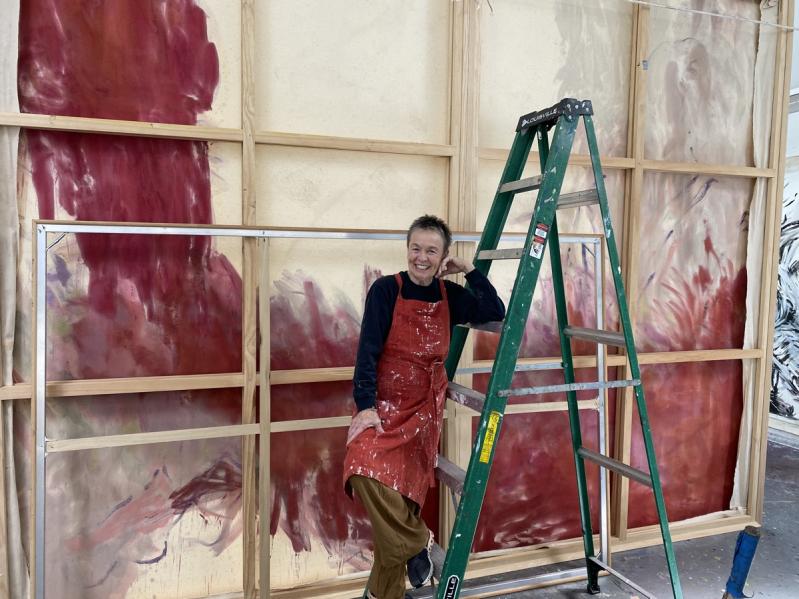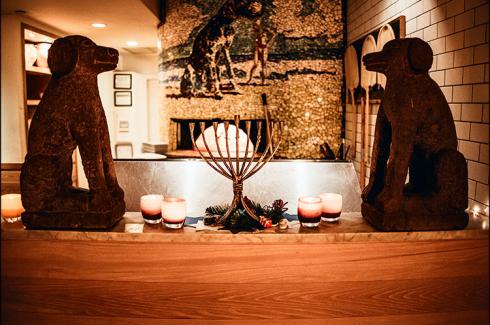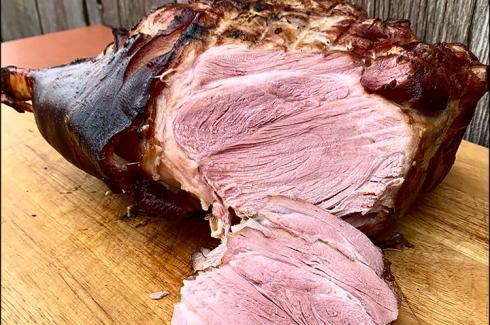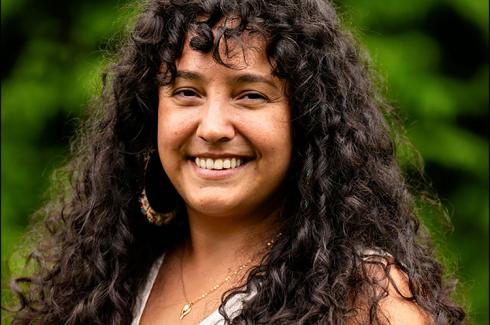As massive framed canvases were being delivered to the Elaine de Kooning House in East Hampton's Northwest Woods, Laurie Anderson, who was beginning her residence there, mused about painting.
"I am not a painter -- I should say that. But I make paintings, and I feel so happy when I'm making them. It's like music for me, it's like improv. I really don't know what I'm doing, so it's even nicer. I do have this idea of making some portraits, so I think I'm going to try to do that."
During a subsequent visit, weeks later, she was asked about the portraits. "I tried, and I did two, and they were among the worst things I've ever seen. Anywhere."
Leading the way into the studio, she gestured at an enormous canvas. "I've been flinging paint around, trying to find a language that works for things of this size."
"I learned a lot at the Hirshhorn," she added, referring to "The Weather," her current exhibition at the Washington, D.C. museum. "They were big paintings. And some of them were not that bad."
She expected criticism for taking up painting, "because if you veer out of your lane, as you know in the art world, you get killed. I'm very conscious of that. I think my trying to make paintings is like a painter saying to me, 'You know, I was thinking of making a record, a hit record.' "
In 1981, Ms. Anderson did just that, with "O Superman." The fact is, she drives a multi-lane highway spanning performance, music, video, film, installation, virtual reality, and, most recently, artificial intelligence.
And she is almost constantly on the move. That first conversation took place four days before she was to deliver the commencement address at the Columbia University School of the Arts.
"I'm thinking back to those days of being at Columbia . . . we were just trying to figure out what to do. It's so utterly different now for artists. None of us ever thought we would ever make a living. We wanted to dance down the road and be free. Now there's a lot of pressure on artists to get their branding done."
The rat-a-tat-tat of a staple gun returned her thoughts to painting. Her Lower Manhattan loft on Canal Street is a media studio, and her house in Springs lacks a studio altogether. The landscape designer Edwina van Gal told her about the de Kooning house. "I was kind of awestruck. I'm a big Elaine de Kooning fan."
"I love it already," she said, before even picking up a brush. "The look of it, the incredible amount of light. It's like being in an iceberg or something. It's a very intense thing to be in somebody's studio. I felt it from the first minute I got here, with all her things around."
Her show at the Hirshhorn is the largest of her work ever held in this country. "When they asked me to do it, I said no. I'm from another world that's full of sound, and it's dark, and it has a lot of words. None of those work in a museum."
A centerpiece of "The Weather" is "Four Talks," a vast black gallery whose walls and floor Ms. Anderson covered with words, phrases, and images in white house paint. She calls it her "selfie room."
Her first thought was to develop a new virtual reality piece for the exhibition. "Then I thought, I really love immersive things -- maybe I'll try to do a room where you get lost in it." Experiencing "Four Talks" is like VR, in that you are surrounded by content as you move through and within it.
"I love VR, because you need your body," she said. "With VR you're turning around, you're doing this, you're doing that, and for that I like it. It's very physical, and I trust that."
Her most recent foray into technology involves artificial intelligence. She was the first artist-in-residence at the Australian Institute for Machine Learning, home of the world's largest language supercomputer. Asked upon her arrival what she hoped to do with it, she thought, it's a supercomputer, can't it figure out its own projects? She finally suggested they teach it to read the Bible.
Three streams of language -- Hebrew, Aramaic, and Greek -- were put on sliders. "The idea was, if you increase the amount of Greek, would the Bible seem more rational? If you increase the Hebrew, would it seem more mystical?" In the end, the machine was loaded with everything Ms. Anderson ever published or said or wrote, and crossed with the three-language Bible.
The result, which is at the Hirshhorn, was "Scroll," a 9,000-page Bible using her vocabulary, her style, her syntax. "It's the Bible according to me," she said.
She next created an algorithm consisting of all the lyrics, interviews, and published words of her late husband, Lou Reed. The computer can respond to a sentence or an image with her algorithms, Reed's, or a combination of the two, producing a different verbal output each time.
"It makes the same jump cuts that I might make in my work," Ms. Anderson said. "I'm addicted to this process. I'm writing an opera using this system. It comes up with all kinds of crazy lines. The opera is a retelling of an old story, so you put the old story in and it grinds out another thing."
"it comes from the vocabulary that was made over many songs and many stories, and it's a mashup," she continued. "But it's not exactly a mashup. It's more like following trails of associations. That's how I am working. Because it's so much fun."
During another visit, speaking of paintings in progress, she said, "Mostly I've been working in black and white and trying not to use mustard and salmon and all of those very tropical colors Elaine de Kooning used."
The works are unfinished, but already there is a dynamic, volatile quality to them. "They're explosions. They're almost like scenes from my opera, which begins with a big explosion that propels the rest of the piece. But that's all I can say about it."
She took a brush and applied some black outlines to another painting that was blazing with reds, golds, and yellows. "The idea was to make it a Tiepolo painting. I think it is one of those things you just keep putting layers on."
A suggestion of the Buddha and a Tibetan prayer wheel were taking shape on one side of the canvas. She smudged the newly applied brushstrokes with a rag, "to turn it more into a drawing, smoky charcoal. The black on top of the gold is going to help a bit."
Ms. Anderson wishes she had more time to spend in the studio, but her world "has gone into hyperdrive." She'd just returned from a meeting in Paris about her opera, caught a Jitney to Springs the same night, and raced back to the city the next afternoon for two weeks of recording.
She and Reed first came here in 2002, renting a house on Atlantic Avenue in Amagansett. They bought the Springs house in 2008.
"At first I didn't like the Hamptons at all. I'm not a party person. Then I discovered hiking and I joined the hiking club. I do feel I live in one of the most beautiful places in the whole world."
She spent the pandemic here, and vowed not to get back on "that stupid merry-go-round. One thing I did learn from the pandemic is how much I love people and need to be around people. When you get involved in your work, sometimes you forget that."
It was time for her to catch the Jitney.




